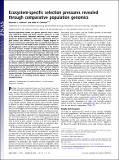Ecosystem-specific selection pressures revealed through comparative population genomics
Author(s)
Chisholm, Sallie (Penny); Coleman, Maureen L
DownloadChisholm_Ecosystem-specific.pdf (895.8Kb)
PUBLISHER_POLICY
Publisher Policy
Article is made available in accordance with the publisher's policy and may be subject to US copyright law. Please refer to the publisher's site for terms of use.
Terms of use
Metadata
Show full item recordAbstract
Bacterial populations harbor vast genetic diversity that is continually shaped by abiotic and biotic selective pressures, as well as by neutral processes. Individuals coexisting in the same geographically defined population often have significantly different gene content, but whether this variation is largely adaptive or neutral remains poorly understood. Here we quantify heterogeneity in gene content for two model marine microbes, Prochlorococcus and Pelagibacter, within and between populations in the Atlantic and Pacific Oceans, to begin to understand the selective pressures that are shaping these “population genomes.” We discovered a large fraction of genes that are rare in each population, reflecting continual gene transfer and loss. Despite this high variation within each population, only a few genes significantly differ in abundance between the two biogeochemically distinct environments; nearly all of these are related to phosphorus acquisition and are enriched in the Atlantic relative to the Pacific. Moreover, P-related genes from the two sites form phylogenetically distinct clusters, whereas housekeeping genes do not, consistent with a recent spread of adaptive P-related genes in the Atlantic populations. These findings implicate phosphorus availability as the dominant selective force driving divergence between these populations, and demonstrate the promise of this approach for revealing selective agents in more complex microbial systems.
Date issued
2010-10Department
Massachusetts Institute of Technology. Department of Biology; Massachusetts Institute of Technology. Department of Civil and Environmental EngineeringJournal
Proceedings of the National Academy of Sciences of the United States of America
Publisher
National Academy of Sciences (U.S.)
Citation
Coleman, M. L., and S. W. Chisholm. “Ecosystem-specific Selection Pressures Revealed Through Comparative Population Genomics.” Proceedings of the National Academy of Sciences 107.43 (2010): 18634–18639. CrossRef. Web.
Version: Final published version
ISSN
0027-8424
1091-6490